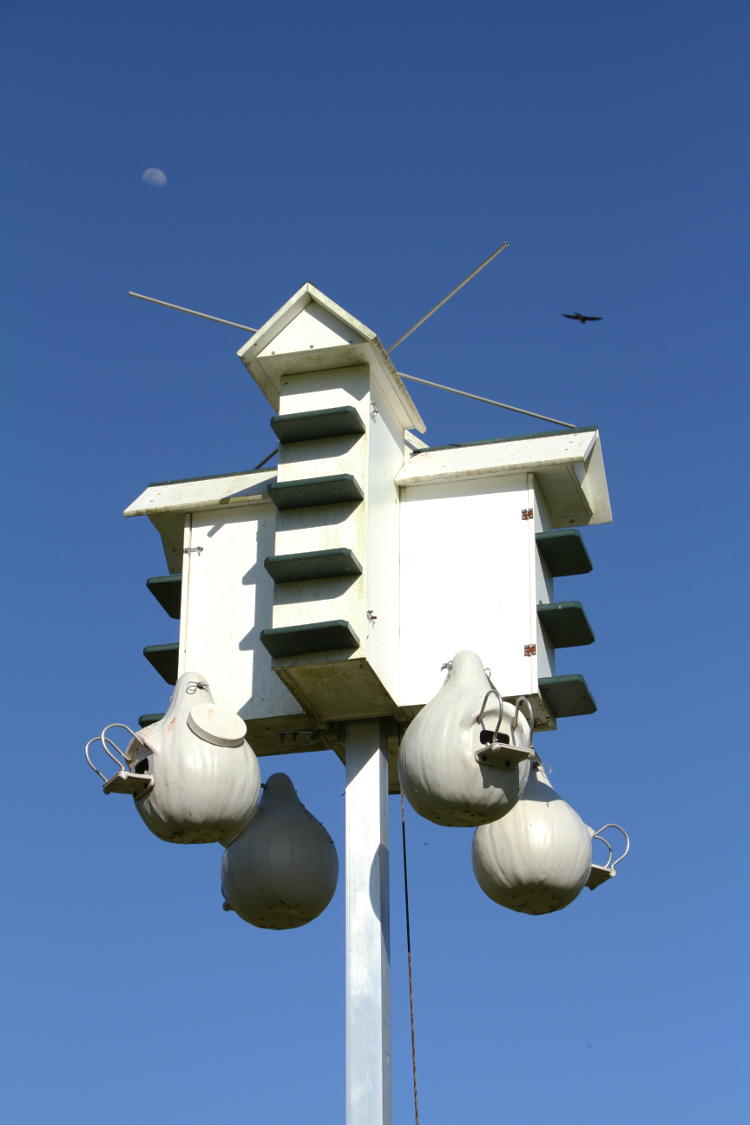
This coming Saturday – that would be May 9th – is World Migratory Bird Day, and since I just got a buttload of bird pics, I could either wait to inundate my millions of readers with them, or post at least some of them ahead of time. You know, to serve as inspiration. To set some goals. To gloat like a brat. However you want to look at it. For several of the past years, we were actually traveling to or from our spring vacation locales on that day, so my chances were much more limited than normal even though they were greatly increased immediately before or after that date, from being someplace with a lot more activity (at least, in the manner that I prefer, which is larger, more exotic birds than locally, but the holiday does not require such of course.) This year however, we did a brief trip the previous weekend, so I will be home and perhaps seeing what I can find here that day. For now, we have the photos from that trip, which was to the Savannah, Georgia region.

We stayed with friends and largely avoided others entirely, so the risk was minimal, plus we had to take advantage of these gas prices for something. Our hosts maintain a couple of high-class nest box condos for purple martins (Progne subis,) so that’s where we’re starting. They do a routine inventory of the activity in the boxes, and we were present for one and got to see the various nests in progress; the whole shebang is on a pulley that lowers it down from its normal position five or six meters up, and all of the boxes have a hinged wall, so it took only minutes to inventory 28 nest boxes and 8 gourds, of which just one had newborns (surprisingly large for such small birds,) but just shy of half had eggs, and all had nesting material – the martins seem to approve.

By the way, all of the box and gourd material is synthetic, which some might frown upon but it makes the nests a lot easier to clean and disinfect, which is necessary for the continued health of the birds. Bacteria, mites, parasites, and the like are not the kinds of things to introduce to newborns.
They had a bunch of feeders too, but I never staked them out in the morning to capture the wide variety of visitors – we had plans for each morning, among those being the Savannah National Wildlife Refuge. Twice. That’s where everything else here was captured, and it was plenty productive. Our timing was pretty good, too: the following day, the main drive in the refuge was due to close for maintenance. Since this was my prime target for the trip, I would have been very annoyed with myself if I’d gotten down there and found I should have researched better.
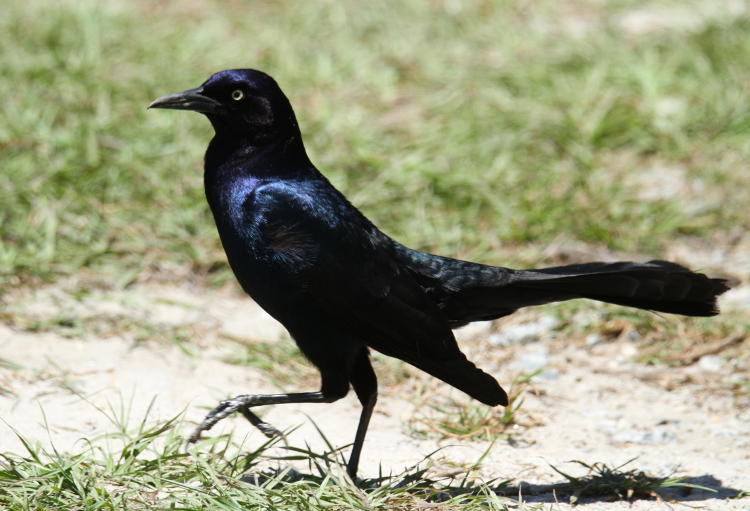
The boat-tailed grackles (Quiscalus major) were in abundant evidence, both visually and audibly with their distinctive rattling calls. They’re bold beggars, learning quickly that ‘people’ often means ‘snacks,’ and will hang around very close by in the hopes that someone will provide some food, either accidentally or on purpose, as we noticed when we stopped for our picnic lunch. When we weren’t forthcoming at one spot, however, a big male quickly discovered his own, and I shot some tight closeups to try and make out what they were.

The best I can say is some kind of caterpillar, perhaps an inchworm-like larva. Grackles are big but not that big, so its meal was only 15 milimeters at best.
Notice the brilliant iridescence of the ‘black’ feathers, which contrasts against the other most-common denizen of the wetlands along the Savannah River, the red-winged blackbird (Agelaius phoeniceus.)
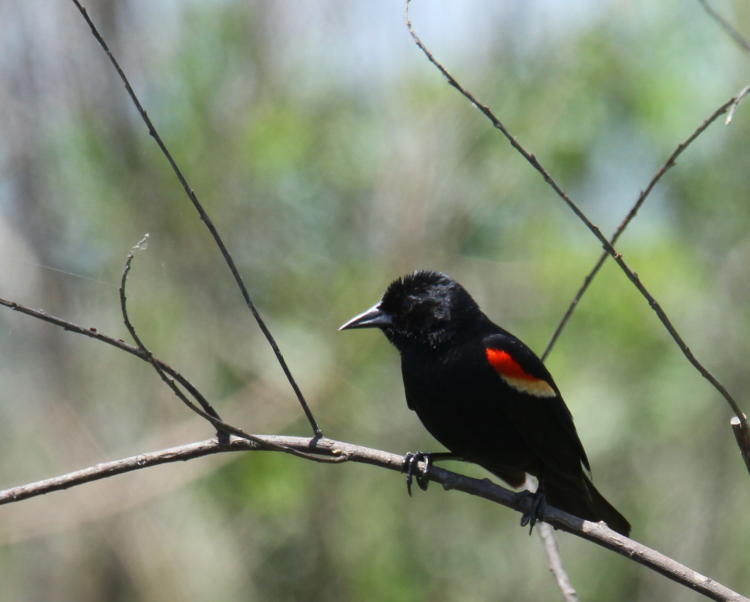
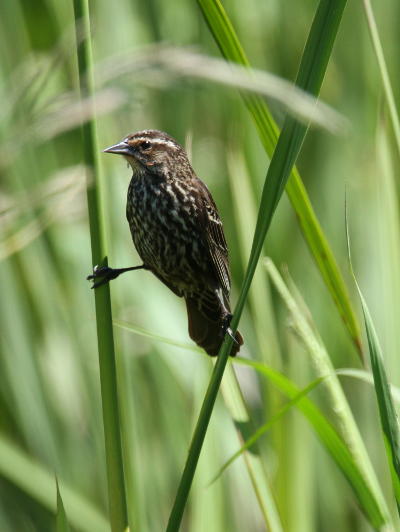 The males are easy to spot when the red and yellow wing bands are displayed, though this isn’t always the case, and they can appear solid black – and it’s a black so deep and matte that only the best lighting allows photos to show any kind of detail at all; we were not so graced on this trip, the light being harsh and contrasty, and while distinct lighting can bring out the body shape, it has to be the right angle, and our models (slightly hyperactive as a species) were not cooperative enough. But a few females provided poses too, showing off the huge difference in coloration as seen at right. They build nests suspended in the tall grasses and reeds, and so benefit from the camouflage, while the males likely attract potential predators away from the nest.
The males are easy to spot when the red and yellow wing bands are displayed, though this isn’t always the case, and they can appear solid black – and it’s a black so deep and matte that only the best lighting allows photos to show any kind of detail at all; we were not so graced on this trip, the light being harsh and contrasty, and while distinct lighting can bring out the body shape, it has to be the right angle, and our models (slightly hyperactive as a species) were not cooperative enough. But a few females provided poses too, showing off the huge difference in coloration as seen at right. They build nests suspended in the tall grasses and reeds, and so benefit from the camouflage, while the males likely attract potential predators away from the nest.
I also got lucky and tracked another male as he came in for a landing on a lily pad, getting a sequence of his spread-winged braking approach, and while the camera somehow failed to lock tightest focus on some of the more stationary targets, it nailed this one quite gratifyingly (I am still researching this issue, by the way – I thought I had it largely corrected but this trip indicated otherwise.) Bear in mind, nearly all of these are with the Tamron 150-600 handheld, and many are cropped tighter from larger frames, so when they look sharp, they’re sharp.
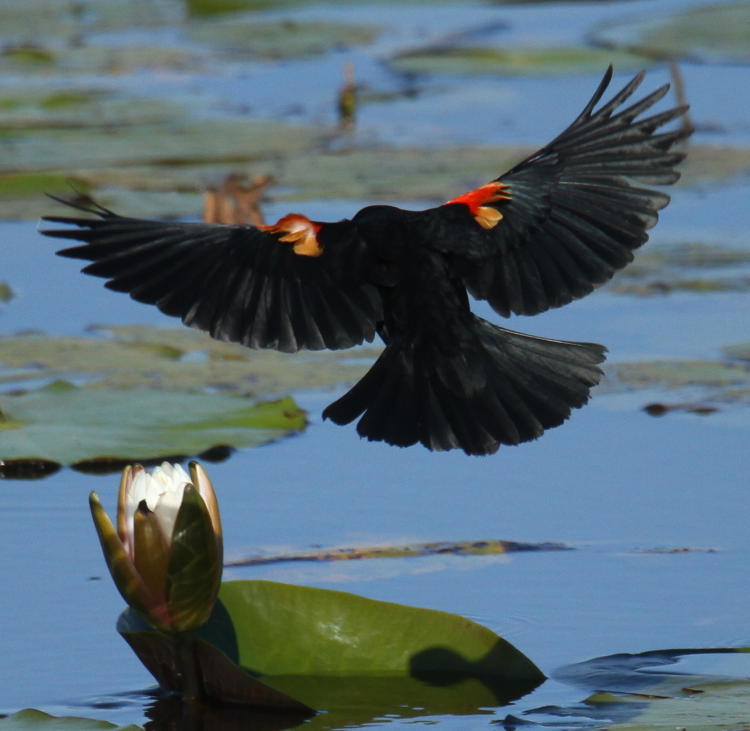
There was another species that none of us recognized, that we kept getting slightly more than fleeting glimpses of, but no really good views of for a while, and it became a goal to get some decent captures, which eventually happened.

This is a bobolink (Dolichonyx oryzivorus,) which I was very pleased to discover because I’d heard of them but never seen one. This particular one is calling after snacking on some of the ripening seeds in the tassels of the marsh reeds, thus the filthy beak. The coloration is very distinctive – our female host was calling them, “calico birds,” which a rear view helps explain a little better.

But hey – we have a bonus today, because I snagged a couple of video clips on the fly, as it were, bracing the long lens against the windowsill of the truck. Nothing exciting, but the call is present at least.
The real photo targets among the wetlands, however, are the wading birds, and we were not disappointed. Not very far along the drive, the road became flanked by broader patches of near-standing water rimmed with reeds and dotted throughout with lily pads, and these were prime habitat for several species, two of which I recognized, and one I was unfamiliar with, only getting a positive ID upon our return. “Our,” by the way, refers to The Girlfriend, The Girlfriend’s Sprog, and myself – I had aimed to go, regardless of accompaniment knowing that they might not be able to break free of obligations, but both ladies finagled the time because they needed to get out too. Add in our hosts to make five all told.
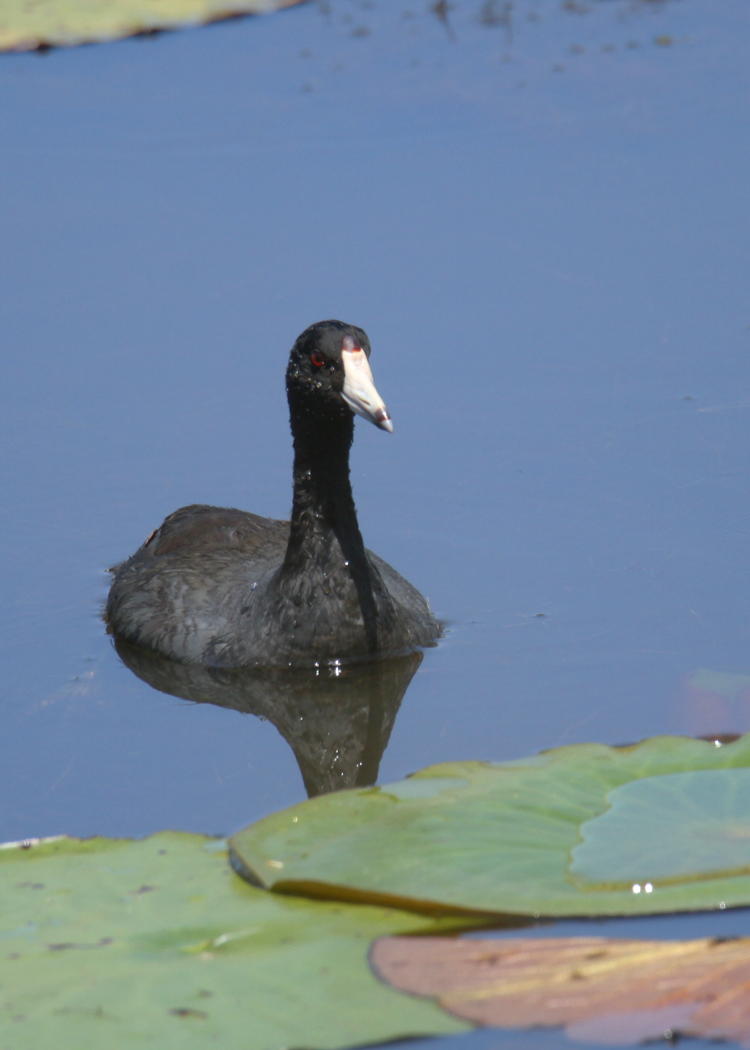
This is one of the ones that I knew right off, though after seeing some others I got a little less sure, but I was right after all – it’s an American coot (Fulica americana,) and they have really cool feet that I was unable to even glimpse this time around, with webbing around each toe but not stretched between them – someday I’ll dig out an old slide I have that shows this well. We’ll throw down another for the profile.
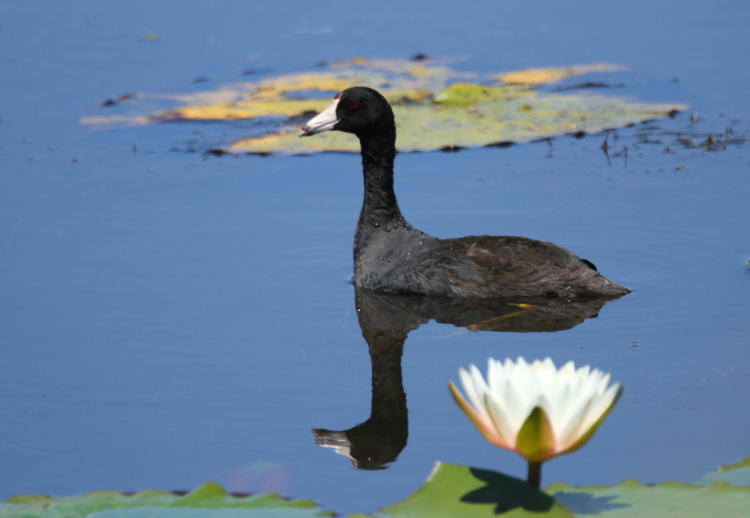
And the lily of course. Use the little elements when you can.
The next one that I recognized was proving a little too elusive, appearing only on the far side of the open water channels and mostly just peeking out from the undergrowth (and possibly nests) from time to time. I include two frames combined here just for the record, and to show off their plumage a little, before moving on to better pictures. I said, “better.” Not, “good.” Though if you want to insist, I won’t argue with public opinion.
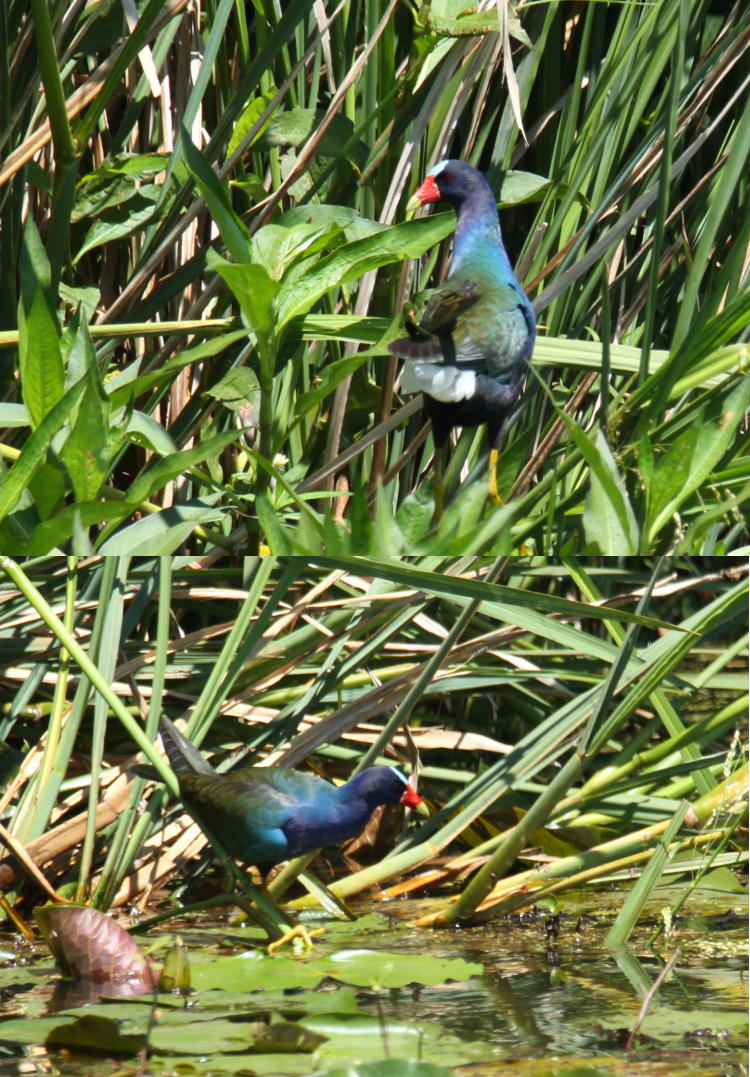
These are purple gallinules (Porphyrio martinicus) – really, hard to mistake for anything else once you’ve seen them, and I’ve spotted them a few times in Florida. I do have to wonder how they got away with naming them ‘purple,’ and I have to imagine no women were around at the time to correct the colors to something more specific, but…
Moving on.

This was the one that stymied me, despite looking so much like the others, but it’s a common moorhen (Gallinula chloropus.) Probably the most numerous among the waders, and like the others, quite adept at prancing along the tops of the pads, not the mention practically running across the water itself (with a bit of help from flapping wings) when territorial squabbles caused one to flee another. One of my bigger regrets was not videotaping (videocarding, whatever) some of what we saw, especially the wide range of sounds that they were all making, but let me paint this picture. The five of us were in a crowded extended-cab pickup truck, in a long line of cars wending its way through the refuge, and shots were being done handheld, often from the back of the pickup bed. Stopping in certain places where there was no room to pass meant everyone behind you waited. In short, not ideal conditions to set up a tripod and shotgun mic to do justice to video, but one of these days I’ll return on my own, on a quiet day, and make the attempt.
Meanwhile, another moorhen looking like a sports advertisement.
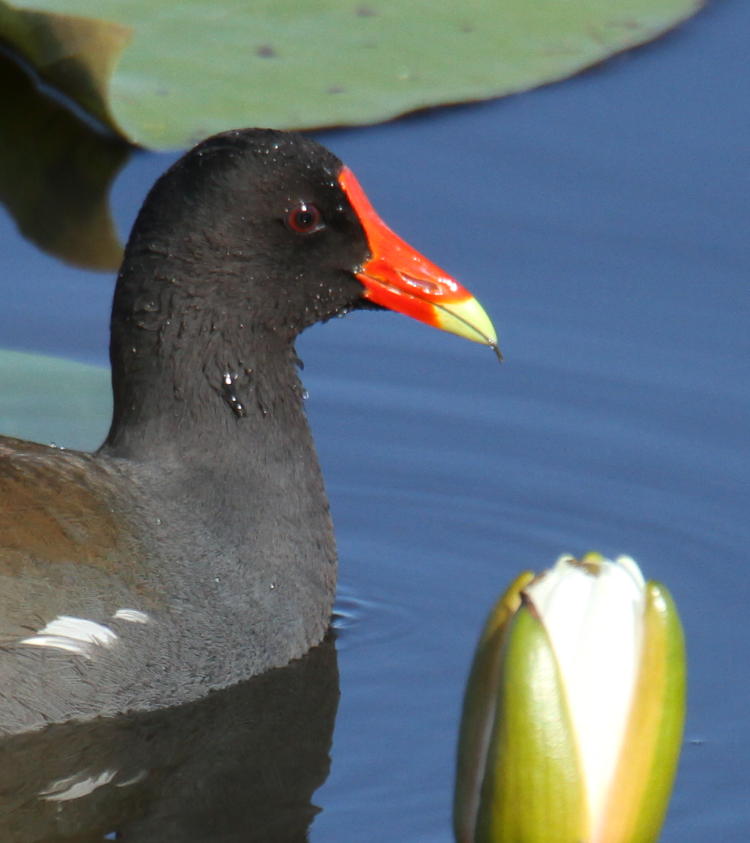
And seriously, you gotta love that vivid, hand-painted look to the bill.
I wasn’t the only one shooting, of course, so I’ll include a few images from the others. The first comes from The Girlfriend, of a snowy egret (Egretta thula) that was foraging around a crossover channel.

For a few minutes, this one was quite active despite a large alligator lounging nearby – either the bird was stupid, or knew the alligator wasn’t hungry, or it was confident in its ability to avoid any sudden lunges. But the little minnows were certainly attracting its attention, judging from the erratic and rapid motions of the bird.
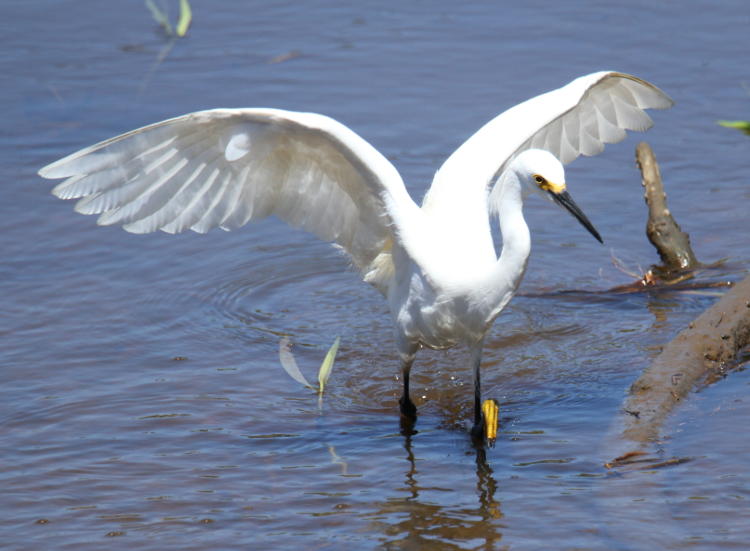
What attracted my eye most from this frame (this is mine again) is the odd leg and foot position on the left leg; you can see the ‘knee’ – actually the bird’s ankle, so no, they bend the correct way – is still under the surface while the foot is raised. The egret was feeling ahead of itself gently with its feet, trying to stir food up from the bottom, and when the nearby gator started to move again, the egret boldly followed it, seeing what the reptile might have stirred up out of the mud.
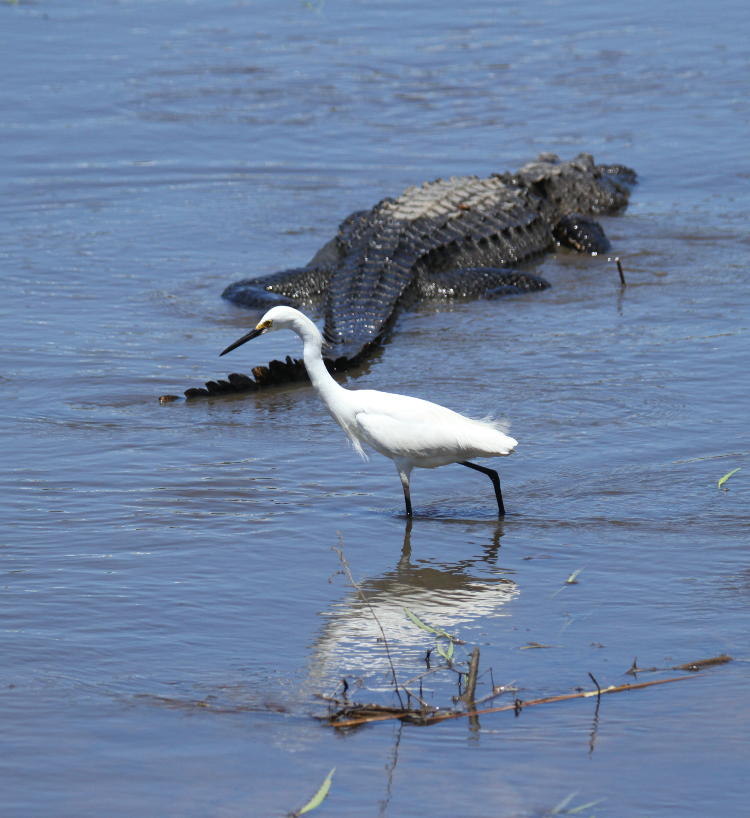
Yes, there will be more alligators, but World Migratory Giant Knobby Lizard Day isn’t for a few months yet, so we’re concentrating on the birds in honor of that holiday, plus the fact that I have too many photos for one post anyway.
Our female host was trying to attract my attention while I was a short distance away chasing another subject – yes, you could get out of the cars when safe to do so, and the gators kept to the channels overall, though road crossing spots were visible if you looked. But anyway, she got several frames of this little fellow while I got only one obscured by reeds, which is unfortunate, because I would have liked to have added this one to my stock.

This is a female least bittern (Ixobrychus exilis,) and the only one that I’ve ever seen, so more power to her for capturing it in such good light. They tend to be shy and secretive birds, and are really adept at dashing through the reeds out of sight even when they’re only a couple of meters off. They’re about the size of a crow in body length, but longer neck and legs of course.
She also captured a female anhinga (Anhinga anhinga – seriously.)
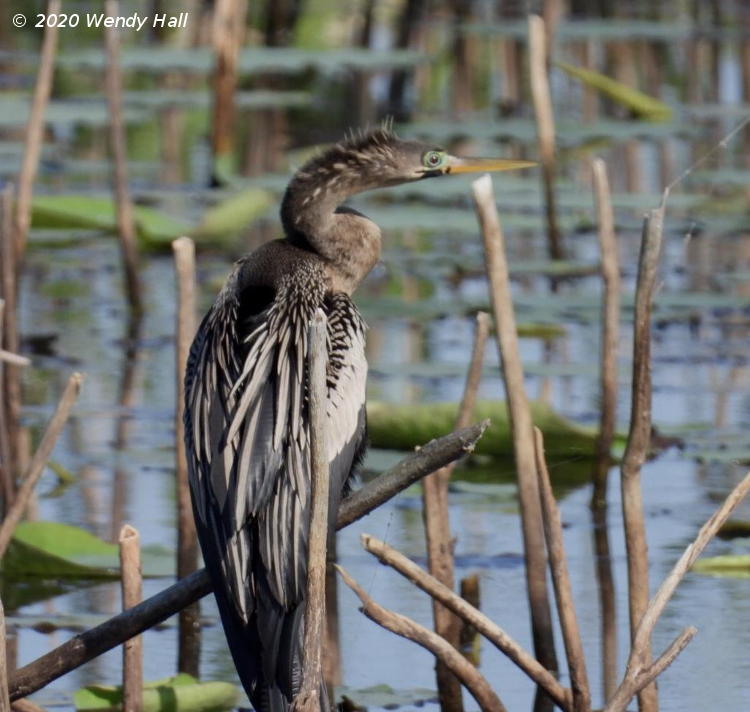
These aren’t quite as hard to spot, though I have no idea where she found this one because I never saw it myself. They’re the kind of bird that fishes while entirely submerged, popping up only occasionally for air and to startle people near the water’s edge, but can often be seen drying their outstretched wings like some misshapen scarecrow near the water. Their call is this great low groaning croak, like me when I’m first waking up.
Not enough birds? How about a clapper rail (Rallus crepitans)? I know you’ve all been clamoring for a clapper rail.

I had seen this from a moderate distance and was misidentifying it, but a proper birder on the trail corrected me. It disappeared into the reeds before I got a close enough or clear enough view of it, so I’m a little surprised Wendy got such a sharp image, but hey, this is why it helps to have a group of people shooting at the same time – someone else ends up capturing things that you miss. Or you may see that as a detriment, if you’re too competitive, but I’m bigger than that. Mostly.
Not so big that I won’t make the last image my own, though.

We’d been out for quite a while and had seen all of the species above, save for perhaps the bobolinks, and I was remarking that we had never seen one of these, which should have been evident giving the conditions. This is a green heron (Butorides virescens,) one of three that we eventually found in two visits to the same refuge – but this is a misleading image, because their plumage really never looks like this. Either the sun angle was just right to cause a brighter sheen to occur, or the camera metering caused a color shift (the white balance was set for full sunlight, so that’s not it,) or maybe a combination of conditions, but the back is typically a deep jade color, tending towards blue in direct light. They’re notorious for remaining out of sight until you’re right on top of them, foraging among concealing reeds and foliage, so this one perched out in the open was a nice find, and I’m glad to nail the detail, even if it doesn’t look quite right.
So let’s see, that’s over 2400 words, 22 images of 12 different species, and even a video clip – I think that covers it for today, and even for Saturday if I get rained out or otherwise unable to pursue the migratory birds on their own holiday. Plus there are still more pics from the trip on the way in a bit.




















































